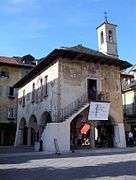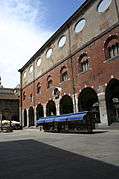Broletto
In Middle Age Communes in Italy, a broletto was the place where the whole population met for democratic assemblies, and where the elected men lived and administrated justice.
Broletto is an ancient Italian word, from medieval Latin "broilum, brogilum", which probably derives from a Celtic word. Its first meaning is "little orchard or garden"; hence the meaning "field surrounded by a wall".
Ancient brolettoes are major buildings in Milan, Brescia, Pavia, Piacenza, Como, Monza, Reggio Emilia, Novara and others. Several places or buildings in northern Italy are called "Broletto".
Gallery
 The broletto at Orta San Giulio, on Lake Orta
The broletto at Orta San Giulio, on Lake Orta The Broletto Nuovo in Milan
The Broletto Nuovo in Milan Under the porch of Broletto Nuovo in Milan
Under the porch of Broletto Nuovo in Milan
List
- Broletto, Arona in Arona, province of Novara
- Palazzo della Ragione, Bergamo in Bergamo
- Broletto, Brescia
- Broletto, Como in Como
- In Cremona, two examples of broletti:
- the Guelph Palazzo Cittanova
- the Ghibelline Palazzo del Comune (Cremona)
- Broletto, Lodi in Lodi
- Palazzo del Podestà, Mantua
- In Milan:
- Palazzo della Ragione, Milan or Broletto Nuovo, one of three broletti
- Palazzo Carmagnola, formerly Broletto Nuovissimo, today hosting the Piccolo Teatro (Milan)
- Arengario (Monza)
- Broletto, Novara in Novara
- Broletto, Orta or Palazzo della Comunità, in Orta San Giulio, province of Novara
- Broletto, Pavia in Pavia
- Broletto, Perugia in Perugia, current seat of the Umbria region
- Palazzo Comunale, Piacenza, or il Gotico
- Broletto, Reggio Emilia in Reggio Emilia
- Palazzo dell'Arengo (Rimini) in Rimini
- Palazzo Biumi and Palazzo Pretorio, Varese in Varese
See also
- Arengario and Arengo
- Palazzo Comunale (disambiguation)
- Palazzo del Podesta (disambiguation)
- Palazzo Pretorio (disambiguation)
- Palazzo della Ragione (disambiguation)
References
This article is issued from Wikipedia - version of the 11/14/2016. The text is available under the Creative Commons Attribution/Share Alike but additional terms may apply for the media files.